Dell Studio XPS 16: the Eyes Have It
by Jarred Walton on April 2, 2009 6:00 PM EST- Posted in
- Laptops
Power Requirements
Power requirements with a laptop plugged in don't necessarily reflect power requirements when a laptop is on battery power. In particular, high-end GPUs run at lower maximum clock speeds when using the battery. Keep this in mind when looking at the following numbers. We test under idle conditions, with a 100% load placed on the CPU via Folding@Home SMP, and finally at maximum load by running FAH SMP at the same time as we loop 3DMark06 (at the native LCD resolution).
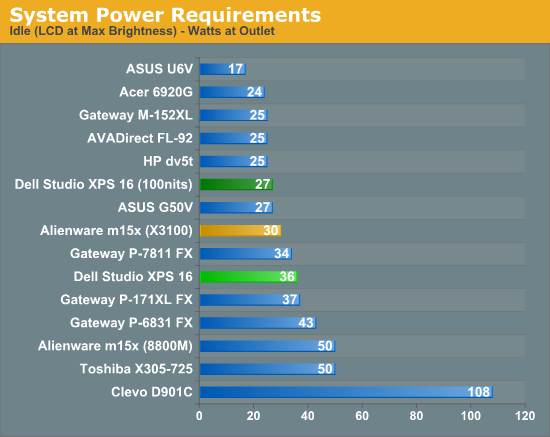
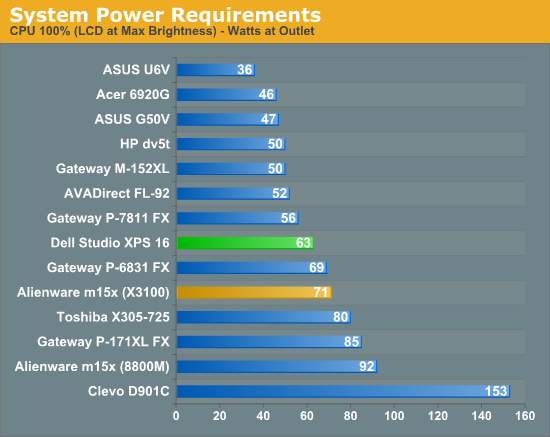

Our power measurements are with the LCD at maximum brightness, which isn't necessarily a fair way of doing things as some LCDs are much brighter than others. Unfortunately, we don't have most of the laptops around to retest. You can see that the Dell Studio XPS 16 uses 9W more power running at maximum brightness, which represents an increase in power draw of 33%. We verified that 9W figure on the other tests, but we didn't include those results in the charts. We don't know if the RGB LEDs inherently use more power than regular laptop backlights, but obviously increasing the backlight intensity requires more power. Luckily, you can often get by running the XPS 16 LCD at around 30-40% brightness (100-130 nits).
Noise Levels
We also ran noise testing using an SPL meter at 24" under the same conditions as our power tests.
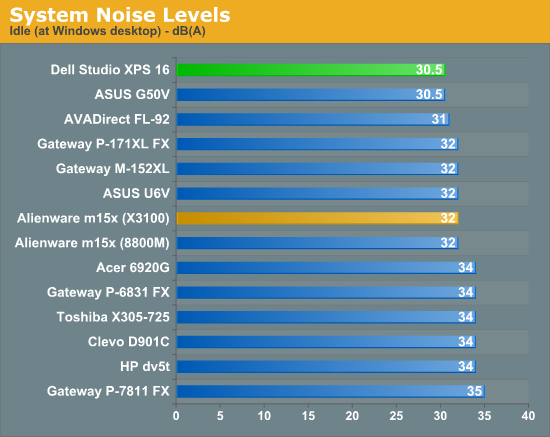
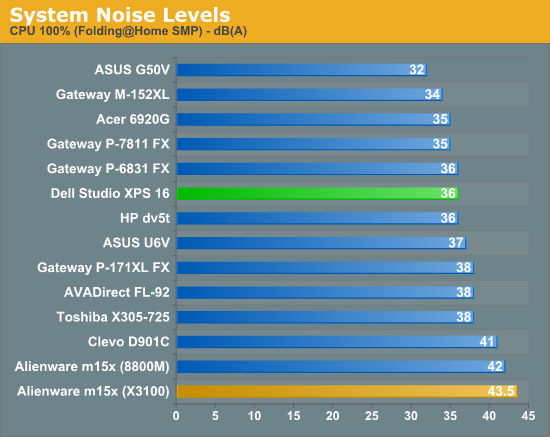
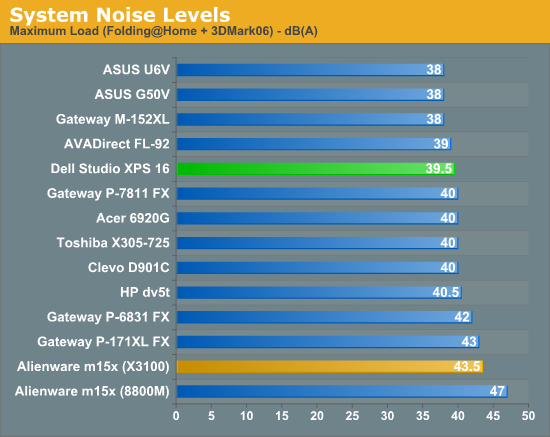
The Studio XPS 16 does reasonably well in terms of noise levels, almost reaching the noise floor of our testing environment (around 28 dB). Once you start to put a load on the system, it does get a bit louder, and extended gaming will usually reach maximum noise levels after a few minutes. The system also takes a while to quiet down after you remove the load, which is likely influenced by the top panel partially blocking the exhaust port.
Temperatures
We didn't create any charts, but we wanted to give a quick rundown of the temperatures you might expect from the Studio XPS 16. We placed a maximum load on the system for 30 minutes and then measured temperatures, so these results are something of a worst-case scenario. Then again, the testing environment was only 67°F, so in warmer conditions it might not be as difficult to make things toasty. We have heard some complaints from users about the XPS 16 getting excessively hot; we wouldn't go that far, but it definitely doesn't run cool to the touch all the time.
We measured temperatures of ~45°C at the exhaust, which isn't too bad. However, temperatures on the bottom of the laptop range from 35° to the 45° as well, with large portions of the bottom measuring above 40°C. The keyboard and palm rest weren't quite as hot, ranging from 30° to 40°C with most of the keyboard staying under 35°. Just to put things in perspective, those temperatures are higher than what we measured on the Toshiba X305-Q725, a result of the smaller chassis with fewer fans.










79 Comments
View All Comments
RU482 - Friday, April 3, 2009 - link
ANy idea what the make/model of the LCD panel?JarredWalton - Friday, April 3, 2009 - link
See the test system page. It looks like a Seiko Epson M077D€160HT according to ASTRA32, but that may or may not be correct.rudy - Thursday, April 2, 2009 - link
The specs for all the machines would be really important here. And they should be included. Why is something like the macbook air which is no where near as powerful even in such a line up? If it is then why aren't other notebooks which pack battery life of an entire day put in there?rudy - Thursday, April 2, 2009 - link
You cannot seriously tell me that the best battery life per watt hour notebook running windows is an alienware seriously...JarredWalton - Thursday, April 2, 2009 - link
Look at the specifics of that Alienware. It's running with the X3100 IGP instead of the discrete GPU. That's why I harp on the need for every other laptop to allow such functionality.As for the remaining laptops, they're all in previous reviews on our site, under the Mobile tab. I just don't think it's necessary to include all 15 or whatever notebook configs in each review. I suppose I can post links to the config pages for reference, though.
As for the MacBook Air, performance isn't super high, but it still has a reasonable Core 2 Duo CPU and I believe NVIDIA IGP, which means performance isn't exactly terrible. There are other notebooks in those charts that aren't particularly high-end as well.
rudy - Thursday, April 2, 2009 - link
The keypad missing on this 16 inch model is a real downer. The space is there I think.JarredWalton - Thursday, April 2, 2009 - link
It's possible to fit in a keypad, but then the rest of the keyboard isn't centered. I have a 15.4" notebook I'm testing with a number keypad and overall I prefer the XPS 16 layout. Then again, that may have more to do with the keyboard on that other laptop simply being super flimsy.... Anyway, the XPS M1730 is still my favorite laptop keyboard, as it's the best of both worlds. It *should* be able to fit on the Studio XPS 16, but for whatever reason Dell didn't go that route.Hrel - Thursday, April 2, 2009 - link
Yeah, good job Jarred Walton; you included 3D Mark results, and not just some of them, frickin' ALL of them... lol. I guess Dereck and Anand could learn a thing or two from you. (That last sentence is said partially sarcastic and no disrespect is meant.) I added that cause that sentence kinda makes me sound like a prick, which I'm not.JarredWalton - Thursday, April 2, 2009 - link
My laptop tests have always included them, but I *really* don't put much stock in 3DMark. I include them simply because they're easy enough to run. Start, walk away, come back in a while and collect the results. I wish more of the game tests were that easy. :)Wesleyrpg - Friday, April 3, 2009 - link
Nice review jarred,i been looking at one of these to replace my XPS m1530, but am concerned that the 3670 is weaker than my 8600mGT in the gaming departmrnt....i'm an AVID WoW player, so which do you think will perform better in WoW?
Also.....those 3dmark scores, were there done in the displays natural resolution or 3dmarks default resolution?
Thanks and keep up the good work